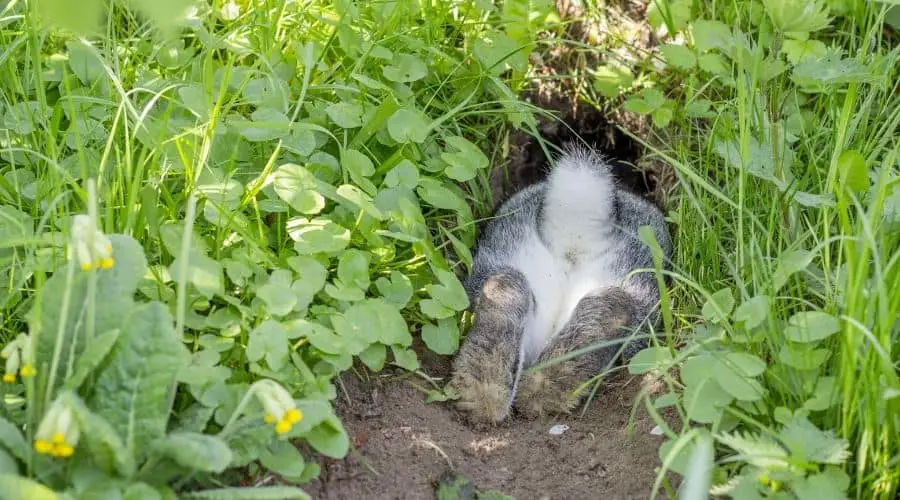Digging is a significant part of what rabbits do in the wild, and burrows can be up to three meters deep. Meanwhile, the shallowest holes rabbits dig are a mere twenty centimeters, which is barely enough to fit inside.
However, regardless of depth, they will often fill in the entrance once it’s complete. Why do rabbits dig holes then fill them in?
The main reason rabbits dig holes and fill them in is to protect their kits from predators. Because rabbits live underground, they have to protect themselves from other animals and even flooding. Rabbits will use leaves, twigs, grass and even their own fur in order to fill in their nest hole.
Table of Contents
Why Do Wild Rabbits Dig Holes Then Fill Them In
Domestic rabbits don’t get a lot of chances to dig burrows, but they have the instincts of their outdoor living cousins.
Wild rabbits dig holes and then fill them in to protect the things inside. They have to improvise since they can’t build a front door to keep out unwanted guests and inclement weather.
Rather than backfilling the entire thing, they simply create a plug. Leaves and twigs, along with some fur they pull, and whatever else the bunny finds lying around will make an excellent blockade at the entrance to their home.
This quick, simple solution helps keep them safe.
1 – To Make It Invisible
Rabbits don’t lay traps or have sharp teeth. While they can defend themselves a little bit with their claws and powerful hind legs, they are not fighters.
Instead, they rely on the ability to run and hide, which means it’s essential to avoid detection.
Hiding in a bush is fine, but rabbits don’t live in bushes. By digging a hole and then filling it in, rabbits know their home is safe and mostly invisible to predators.
Staying out of sight is an intelligent way to live longer.
2 – Hiding The Babies From Predators
A pregnant rabbit will dig a hole and then fill it in, but not all at once. First, the mama bunny makes a place for her babies.
She will line it with fur and make it ready. Then when she’s ready, she will have her babies in the shallow hole she’s created.
As Squeaks and Nibbles explains it, “Eastern Cottontails… make their nest by digging a shallow basin, about five to seven inches long, four or five inches wide, and three and a half to five inches deep. These are also known as pocket nests. To make it warm and cozy, the pregnant doe plucks fur from all over her own body and uses it to line the nest. She’ll also bring in grass and straw from outside the nest to insulate it and make it comfy. And finally, she’ll add a layer of grass, straw, leaves, and stems from herbaceous plants with which to conceal her babies. She might also rely on vegetation that is already overhanging the nest.”
Covering the babies makes it more likely that they will survive. The mother rabbit has to leave her young unattended when she heads out to get food, which leaves them vulnerable to predators.
A superficial layer of twigs and vegetation can save their lives.
3 – Protecting Resources
Rabbits don’t store food for winters like squirrels and other creatures do, so they don’t have cluttered burrows. However, they do have some resources to protect.
A good bed takes time for the rabbit to put together since they are meticulous and picky about how they keep their homes.
It would be upsetting to come home and find the materials stolen and scattered, so covering the entrance to their hole by filling it in is a security system.
4 – Weather
Rain, snow, sleet, hail, and melting ice are unpleasant bedfellows. For a densely furred creature like the rabbit, being damp can mean hypothermia as they hunt for food in the cooler seasons.
Filling in the entrance can help prevent excess moisture from leaking in.
5 – Prevent Burrow Theft
Rabbits will live an average of around six to nine years and they don’t want to have to spend all their time digging new homes.
Expanding on an existing warren is much more fulfilling. Sadly there are creatures that are all too happy to chase out, kill or eat rabbits and take over their homes.
As Animals Mom points out, “Some burrowing creatures rarely dig their own burrows and rely on other creatures to make their homes for them. Coyotes, foxes, and burrowing owls all steal preconstructed burrows to use as their own.”
6 – Boredom
Rabbits are very smart animals and they need a lot of enrichment and stimulation to keep themselves entertained.
Digging is fulfilling to bunnies, so they sometimes do it as a sort of practice. Digging can help alleviate boredom and offer’s an otherwise unoccupied rabbit a task that makes them happy.
After all, life isn’t all about finding carrots and mating.
Helpful Tips To Know About Why Rabbits Dig Holes Then Fill Them In
Rabbits are incredibly bright and they understand that a burrow is only as good as your ability to keep it safe and dry.
By going out of their way to cover up the entrance with readily available materials found in nature, rabbits keep their babies safe, and their homes warm and dry.
Here are more helpful tips to know about why rabbits dig holes then fill them in.
- Digging down into the ground to make a home is a smart way to stay out of sight and keep your family safe from predators. Plus, it provides a lot of insulation against temperature fluctuations in summer and winter. The only place a well-dug underground burrow is vulnerable is right at the entrance, so that’s where they require extra effort.
- Many burrowing creatures seal up the entrances of their homes in winter and hibernate. However, rabbits are active all year long and will leave their cozy home searching for twigs and bark to munch on.
- A young rabbit is mature enough to leave home around six months old. At that point, they will move away and dig their own burrow rather than reusing their childhood home.
- A warren is a series of interconnected nests, whereas a burrow is just a single rabbit’s hole. Females are more likely to dig warrens. Males are often happy with a ‘scratch’ or shallow hole they use to scent mark and then lay in to stay cool in summer.
Final Thoughts
Digging your home into the earth makes it a lot harder for most predators to reach you, which is great when you’re a mostly defenseless, fluffy morsel like a rabbit.
A hole is a great place to hide babies as well. The only thing most wild rabbits need to concern themselves with once the hole is dug is how to mask the entrance.
So they came up with an ingenious solution. By filling the hole with leaves, fur, and twigs, it becomes somewhat invisible, making it harder for a random predator to spot by accident.
Plus, this behavior has the added benefit of helping keep out rain and snow.

